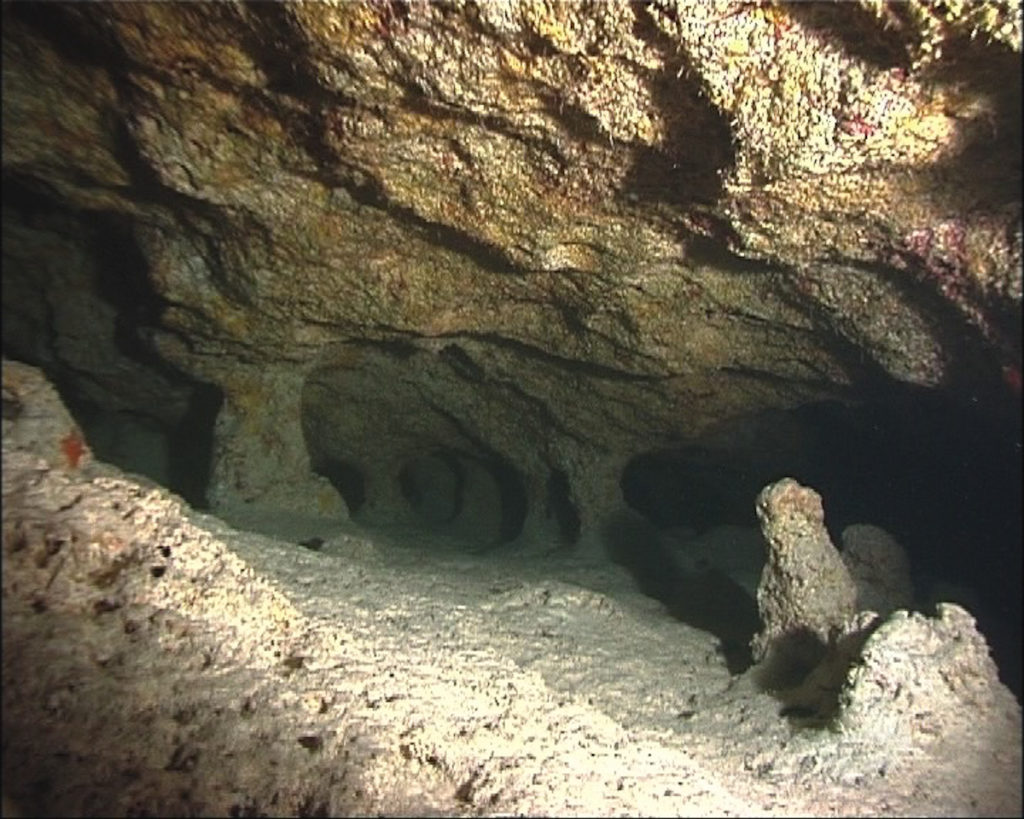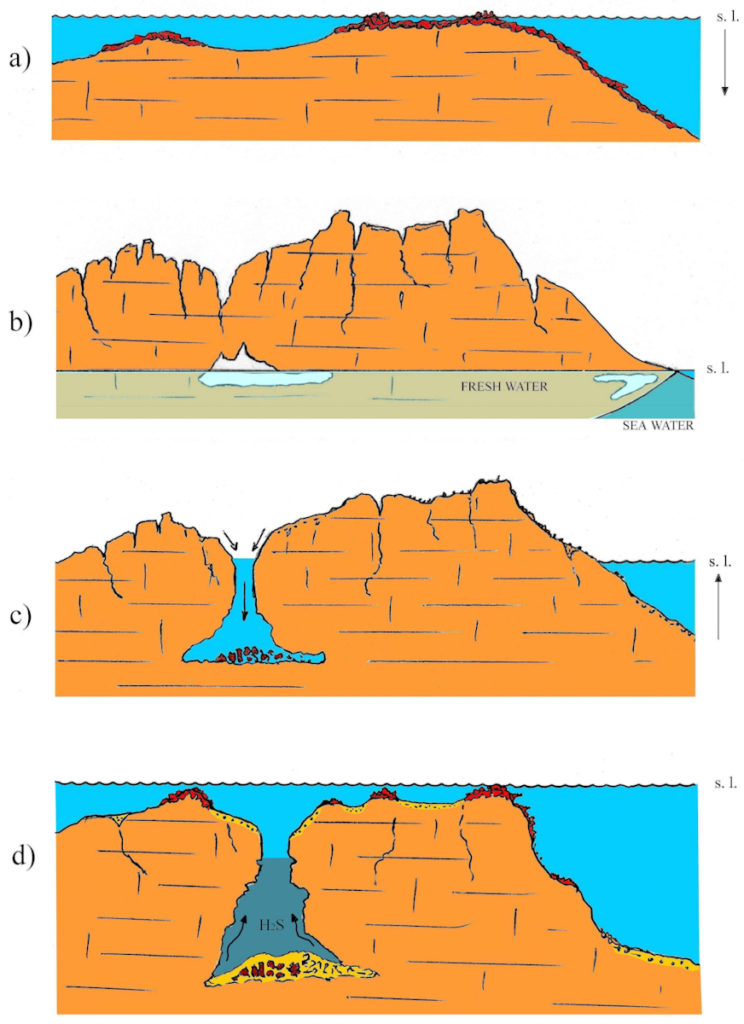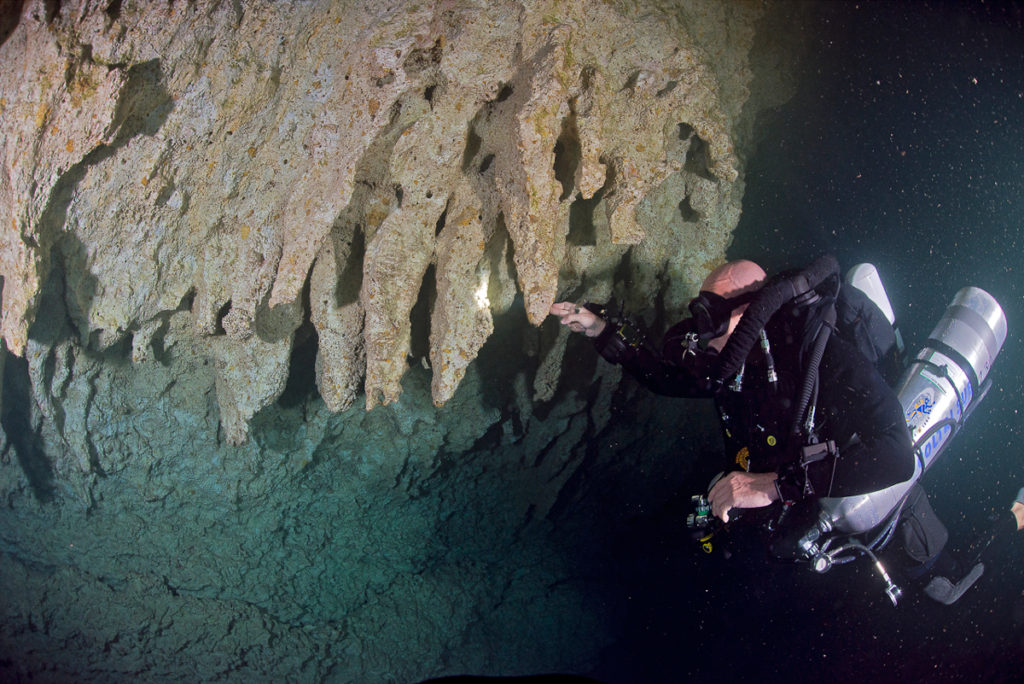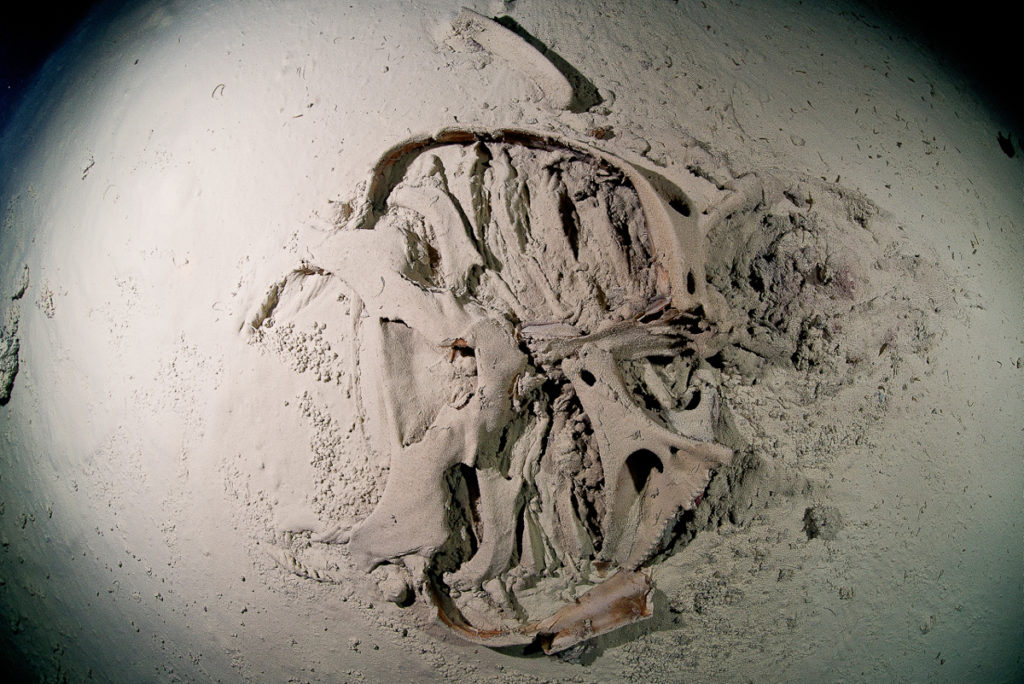During one of the cruises set up by Luxury Yacht Maldives, a team of experts explored a wide and deep cavity in the Ari atoll to investigate the origin of its formation and ecological aspects. First responses to such study suggest the Maldivian blue holes originate from particular kurstic phenomena, caused by corrosion of coral rock by hydrogen sulfide, through bacterial action.
Part Two – The Scientific Exploration
For a while a rumour in the Italian diving community had it there was a place in the Maldives with deep caves similar to the famous Blue Holes of Bahamas and Caribbeans.
In 1998 Massimo Sandrini from Luxury Yacht Maldives discovered, by total chance while retrieving a stuck anchor, such a cavity in a lagoon in Ari atoll. Further dives on site confirmed the existence of such blue hole, a very wide hole whose depth was unkwnown and the extimated perimeter wasn’t inferior to 150 mts.
There is no trace of such a deep bottom depression on any chart of the area. Luxury Yacht Maldives and the International School for Scientific Diving (ISSD), a CMAS and UNESCO acknowledged organisations, made up of scientists and professionals connected to Universities and other Research entities, collaborated for several years to realise scientific cruises for underwater research.
Scientific cruises starting from 1998 have rightly put among their goals the initial study of the Maldivian Blue Hole.
The very first cruise of exploration and investigations on the Blue Hole took place on the boats managed by LYM and among others, partook several experts and underwater researchers: Giuseppe Baldelli, Giovanna Bernardini, C. Nike Bianchi, Franco Bonolis, Francesco Cinelli, Paolo Colantoni, Daniela Mencucci, Carla Morri, Donatella Telli, Massimo Sandrini, Anna Proietti Zolla.
Related Article: The Blue Hole in the Maldives, Part One
The exploration
The first description of the Blue Hole required two days by a 8 divers divided in buddy teams dedicated to each aspect: topography, bathymetry, photography, video, biological observations, samples.
The general topographical survey and bathymetry were carried out through the use of strongholds and measuring ropes, compasses, depth gauges and portable underwater sonars.
Walls, cavities and existing biocenosis have been photographed and samples of water have been collected. Working conditions were such that demanded the utmost caution for the darnkess, the murkiness and the depth.
Luckily, the temperature of Maldivian waters allows the use of a very light equipment, and, in consequence, few weights: both factors facilitating the underwater operation.
The Maldivian Blue Hole resulted in a wide cavity dome shaped, with a semicircular opening of about 70 mts diameter, sloping down larger and larger up to reach the depth of 82 meters. The entrance opens up like a massive hatch, on a bed of 30 mts of a large lagoon, near a coral tower whose top is at about 13 mts depth. Water is rather foggy, characterized by a weird white clumps getting denser and denser at about 40/50 mts. Below it becomes complete dark and it is mandatory to use of adequate flashlights.
On the other hand, water gets clearer: this is because of the chemical gradient in the water column, making water retain the suspended particles above such depth. This chemical gradient, also known technically as chemocline (just like it’s a thermocline the temperature gradient famous among divers), is responsible of the thickening of the “flakes” and, in consequence, of the complete disappearence of the light below.
A strong smell of hydrogen sulfide (H2S), even perceived by divers through mask and regulator, suggests that the chemical gradient was due to the presence of sulfurs in the deep waters of the cavity.
The same theory was also suggested by the blackening of the leads below 50 mts. Samples of water at various depth has clearly demonstrated such hypothesis: hydrogen sulfide is absent at 40 mts, present in weak concentration at 50 mts, and slowly increases in quantity the deeper it gets.

The biological population
Hydrogen sulfide is toxic for most organisms; besides, its presence excludes the one of dissolved oxygen. Below the chemocline therefore, there is no trace of animal life.
The walls are plain bare, with the exception of reddish and greenish coats which probably stem from bacteria; the walls are also dotted by numerous niches and corrosion grooves.
Getting closer to the chemocline the coats of bacteria increase, whereas the rock isn’t covered by a layer of ground. At the flocculus thickening zone soft white filaments are observed attached to the walls. Similar filaments, reaching up to 1 or 2 cms in lenght, seem to be the basis for the formation of the flakes.
Examining them at a larger magnifying, they appear of bacterial origin, probably Beggiatoa, known for being able to operate the oxidation from hydrogen sulfide (H2S) to sulfuric acid (H2SO4).
From this oxidation they gain the energy for their existence. They naturally need oxygen, and that is the reason why the Beggiatoa live to the ’”interface” between water rich in hydrogen sulfide (like that below the chemocline) and water normally oxygenated (like that above the chemocline).In the oxygenated water above the chemocline there is animal life. At first there are only a few encrusting organisms, such as sponges.
In the cracks in proximity of the cavity entrance some fish find shelter, although no evidence whatsoever was found of a legendary grouper known for being hanging around that area.
Right outside the Blue Hole the coral communities look impoverished, characterized by crusting and soft corals alone, which indicates the effect of some environmental stress: murkiness, high sedimentation of the ground or, who knows? Some occasional leak of hydrogen sulfide might be its cause.
Theory on the origin of the Blue Hole
Sub-circular depressions tens of meters deep but of modest diameter are known yet very infrequent morphologies. However, they pose the problem of their origin, often the object of imaginative and unreliable speculations.
The phenomena originating such morphologies can be traced back to at least three situations, recognisable in different parts of the world, both on land and on the sea bottom.

They are:
- a) volcanic eruptions
- b) salty solution present in geologic successions
- c) karst
a) It is known that the substrate on which the Maldives originated is volcanic but, as it has been demonstrated by the perforations carried out, it is currently covered by at least 2000 meters of coral formations which, with their growth, have compensated for the continuous sinking of the volcanic systems started about 40 million years ago.
Since then no eruptions have been reported in the area. It therefore appears very unlikely (if not excluded) that the depression may be due to the collapse of a recent volcanic structure (caldera) in the Maldives.
b) In different parts of the world, even on the seabed, depressions are known because of the solution of salt levels in depth, which causes the sinking of surface layers.
This is, for example, the explanation of extensive subsidence in the deep areas of the Red Sea, the Gulf of Mexico and even the Mediterranean. Once again, however, this cannot be the case in the Maldives, where no perforation has ever found salt levels whose mobility and solution could have caused a sinking cavity.
c) On the other hand, the depression observed is probably due to old karst. It can recall, in fact, a structure similar to those known on the mainland as sinkholes or valleys. In support of this theory, it can be observed that the Maldives show frequent traces of karst corrosion in the coral rock.
In fact, the furrows, caves and other morphologies that indicate phases of emergence of the cliffs with consequent subaerial evolution of the landscape mainly due to rainwater, are very abundant.
In order to support the theory of simple karst origin, it is however necessary to demonstrate that at this point an enormous quantity of fresh water loaded with CO2 from an extensive collection basin entered the subsoil, a basin of which, however, there is no trace in the Blue Hole area.
This explanation also appears to be poorly supported by the evidence. In the water that fills our depression, however, the presence of hydrogen sulphide was found in concentrations that seem to increase with depth.
This element could be the key to explain the origin of this particular blue hole which could represent a “hypogenic” cavity the roof of which collapsed. This type of cavity is due not to rainwater which, because of the gravity penetrates the rock from top to bottom causing corrosion according to the classic karst phenomenon scheme, but is formed by ascending fluids: in our case, from the rise of hydrogen sulphide (H2S).
Caves of this type are known in different parts of the world and also in Italy, where hydrogen sulphide is contained in thermal convoys (like those in the caves of Capo Palinuro) but also in cold waters (Caves of Frasassi). Corrosion (and hyper-karst) would occur in an oxygenated environment where the hydrogen sulphide would change to sulfuric, which, reacting with the limestone, would also favor the release of carbon dioxide which in turn would further increase corrosion.
In the Maldives, therefore, H2S of deep origin, going up and getting in touch with sea water, would react by dissolving the calcium carbonate that makes up the cliffs, forming cavities that exceptionally reach the surface.
However, no one has ever described surface structures of the type found in the Ari atoll. And, above all, no one, before our discovery of the presence of hydrogen sulphide in the blue hole of the Maldives, invoked the hypogenic mechanism for the formation of cavities. But what could be the origin of hydrogen sulphide in the Maldives?
In the first place it could come from the sulphates contained in the deep layers, according to the scheme invoked to explain the composition of the deep waters circulating in the Italian Apennines, but the geological situation of the Maldives is very different.
The reporting of the presence of anhydrite (CaSO4) in wells drilled in the area has not been confirmed, but rather heatedly contested. In the caves of Carlsad (New Mexico) it has been shown for the first time that large cavities can be formed by corrosion of limestones by hydrogen sulphide (H2S) rather than carbonic acid (CO2): it was in particular speculated that these acids can be associated with the migration of hydrocarbons contained in the rock mass. Again, however, oil and methane would have come into contact with anhydrite to form hydrogen sulphide.
In the Maldives, hydrocarbon flows can certainly be assumed, which can go up through faults and fractures of the carbonate mass, but once again it is not enough, even if there are often hydrocarbons rich in sulfur compounds.
There remains the reduction of sulphates, abundant in sea water, operated in an environment that is not oxygenated by reducing sulphate bacteria.Summarizing, therefore, there is the possibility that hydrogen sulphide derives from bacterial activity, from the oxidation of oil and from the oil itself in buried environments, but close to the surface. Specific research, with determination of the isotopic composition of the individual products, may clarify the problem in the future.

Diving the Blue Hole
Diving in the Blue Hole is not the easiest. The depth to which it opens is already quite significant (30 m) and the waters are cloudy and poorly lit, also due to the presence of the flocculate in suspension. A visit to the area overlooking the entrance and a limited penetration of the same, up to the strip above the chemocline is available to already experienced divers, in small groups and well guided by guides who know the cavity and hazards of this dive perfectly.Entering more deeply the Blue Hole, going below the chemocline, is reserved for very experienced divers, adequately equipped and organized. Penetrating it represents a mixture of night diveing deep diving, diving in murky waters and cave diving. Furthermore, the dive itself can provoke strong emotions which, if on one hand it constitute its charm, on the other one, it can increase the degree of difficulty.








